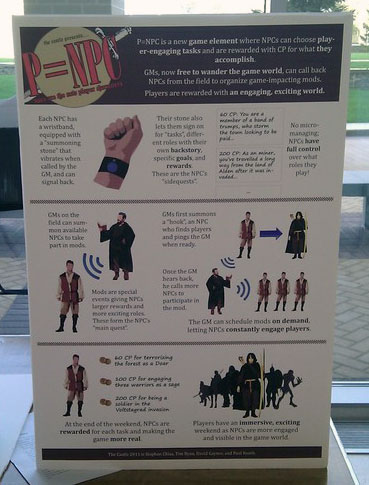I took this class in Spring of 2011. The basis of this class was to learn and experience the user-oriented design process. I worked with a team of 3 other students from Olin College of Engineering. We went through an iterative process of interviewing, ideating, collaborating, participating, and prototyping.
The user group we designed for were Live Action Role Players, aka LARPers. LARPers are groups of people who go out to fields or campsites and spend the weekend role-playing. This role-playing consists of various adventuring and acting through the eyes of a character they create. In a nutshell, it is the real-life version of the tabletop game Dungeons and Dragons.
How LARPs work
At a LARP you will find three different roles. Game Masters (GM), Player Characters (PC), and non-player characters (NPC).
- GM run and manage the event. They control everything at the LARP event. They organize getting a campground for the weekend to creating the story and quests for the weekend.
- PC pay to play at the event. PC have created their own character for this LARP group. They come to the LARP and expect to have fun, go on quests, and kill a ton of bad guys.
- NPC are volunteers for the event. They get orders from the GM on what to do. These can vary from the GM saying "set this quest up" to "Nothing has happened at town in a while--I need 4 of you to dress up as goblins and attack the town". Their goal is to make sure the PCs have a fun weekend by following the orders of the GM.
Final Design
Our final product was a system that would allow GMs to wirelessly communicate with the NPCs in order to keep the LARP exciting the entire weekend. This would allow the PCs to have a more immersive experience at the LARP.
